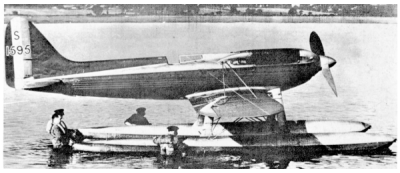

 |  |
| Aviation advances were rapid during the period between the wars. Spurring this advancement on were several contests, rewards, and trophies offered up by philanthropists. One of the most famous contests was the Schneider Trophy International Contest. This contest was intended to open up the sea as an aerodrome. The first contest was held in 1913 in Monaco and continued up until 1931, with sporadic breaks due to WWI and other reasons. In 1931, Great Britain won the trophy outright with its third straight win. This astounding victory sequence was made possible by the advanced seaplane designs by Reginald J. Mitchell of Supermarine. Building on experience gained in the Schneider Trophy seaplanes, Reginald Mitchell went on to design what is arguably the most famous WWII fighter, the Supermarine Spitfire. The British win in 1927 prompted the Royal Aero Club to ask to extend the period between races to two years due to the difficulties in building a plane that could beat existing times. Everyone agreed that the extra time would be useful. While America, France and Italy went to work on their next Schneider entries, Reginald Mitchell and Supermarine looked over their last plane, the S5. The Napier Lion powerplant was at the end of its development, which led R.J. Mitchell to look elsewhere. In this search for a more powerful engine, he met up with Sir Henry Royce, who promised an engine that could provide 1500hp. Based on this engine, R.J. Mitchell started design work on the S6, his first all metal racer. The Rolls-Royce "R" engine was developed from the successful "buzzard" powerplant. The additional power was obtained from racing superchargers, a higher compression ratio, and greatly increased operating speeds. Other techical advancements resulted in a racing engine that put out 1900 brake horsepower at 2900rpm while only weighing 1530lbs. This was an incredible performance for Rolls-Royce, and helped greatly in winning the 1929 trophy. For 1931, the power was increased even m0re to 2350bhp at 3200rpm while adding only 100lbs to the weight. All of this power needed a well designed plane to put it into. R.J. Mitchell had many obstacles to overcome with this new design. The new Rolls-Royce engine was much bigger and heavier than the old Napier Lion, so as such the S6 was bigger than the S5, weighing in at 5771lbs versus 3250lbs of the S5. The bigger engine also proved to be a thirsty engine, which resulted in some creativity in placing the fuel tanks. It was decided to use the center portion of the floats as gas tanks, with the fuel lines running up the supports. To offset the torque of the engine, more fuel was placed in the starboard float. The tops of the floats were also used as a radiator, with coolant flowing through a series of pipes on the surface. This method was also used on the fuselage sides as well, but for the oil. This method increased the efficiancy of the oil cooling system by as much as 40%. All of these innovations helped Supermarine win the 1929 race with the S6. Held off Ryde, Isle of Wight, Flight Officer H. R. D. Waghorn flew the S6 N247 around the closed quadrilateral course seven times,with an average speed of 328.63mph. Second place went to the other S6, N248, but was later disqualified for missing a turn. In 1931, with two wins under their belt, R. J. Mitchell and Supermarine took to the skies with their uprated S6B. Flight Lieutenant J. N. Boothman ran the course with an average speed of 340mph and secured the final victory of the Schneider Trophy for Great Britain. The outstanding success of the Supermarine/Rolls-Royce team in the Schneider Trophy wins cemented a relationship that later proved to be essential to the survival of England. With the aerodynamic information gleaned from the S6 and S6B, R. J. Mitchell was able to go on and design the superlative Spitfire, while Sir Henry Royce was able to build on the "R" engine and end up developing the "Merlin" and "Griffon" engines, which, when the two combined again in the skies over England, gave the Spitfire to those few. |
Sources:
Chine Lines #7
pp14-15 "The Supermarine S.5 and the 1927 Schneider" by Bill Devins
Profile Publications #39
The Supermarine S4-S6B by C. F. Andrews and W. G. Cox
Copyright ©1997 Chris Banyai-Riepl